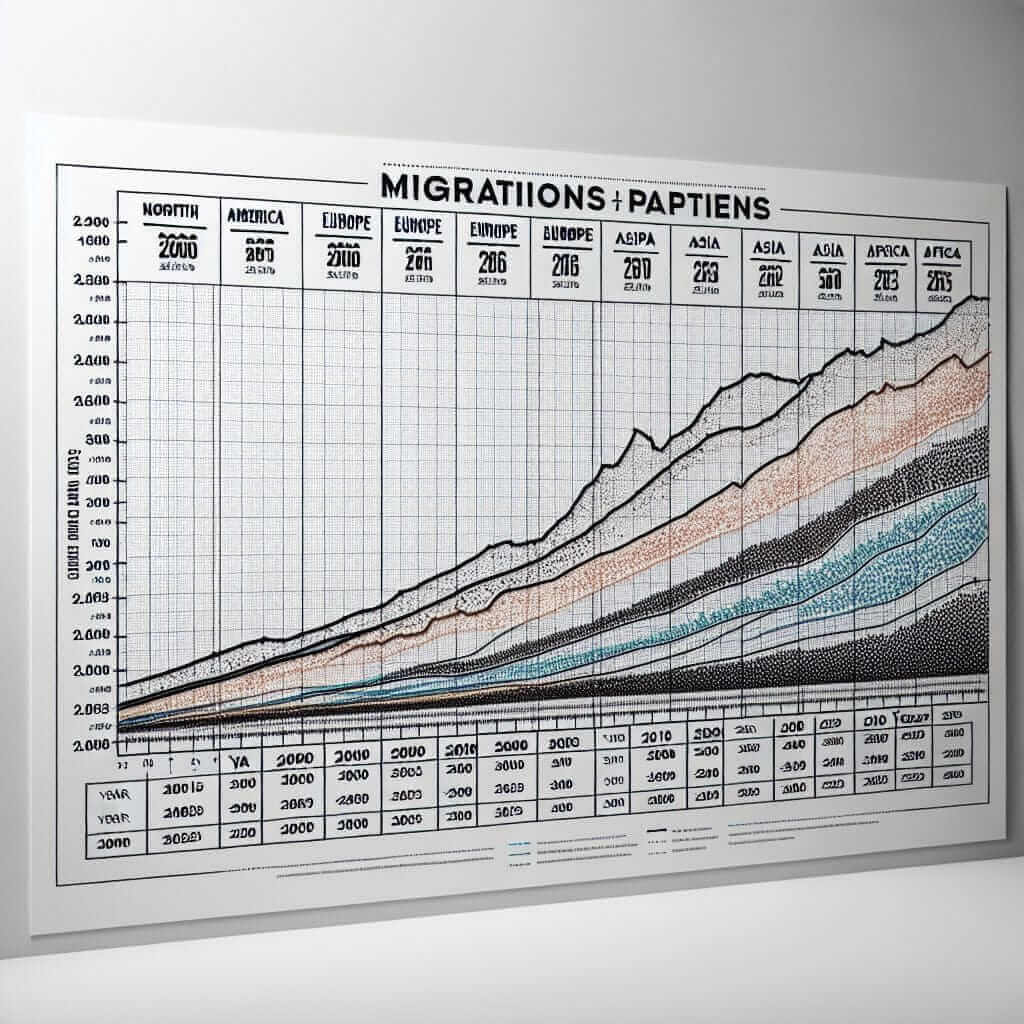Migration has been a significant factor influencing population dynamics across the globe. Understanding the patterns and trends of migration can offer deep insights into economic, political, and social changes. This topic, “Migration Patterns in Different Regions (2000-2023),” is highly relevant for IELTS Writing Task 1, where candidates often have to describe graphs, charts, or maps. In this article, we will explore this topic in detail with examples, vocabulary, and tips to help you achieve a high score.
Sample IELTS Task 1 Question
Let’s begin by presenting a sample question related to the given topic:
Task: The graph below shows the migration patterns in four different regions from 2000 to 2023. Summarize the information by selecting and reporting the main features, and make comparisons where relevant.
Graph or chart image could be placed here

Analyzing the Graph
Key Observations
-
Regions Covered:
- North America
- Europe
- Asia
- Africa
-
Trends:
- Increase or decrease in migration numbers over the years
- Peaks or troughs in specific years
- Comparisons between regions
Simplified Analysis Example:
- North America: Steady increase in migration until 2015, then a sharp decline.
- Europe: Moderate growth with a significant peak in 2010.
- Asia: Significant fluctuations with an overall downward trend.
- Africa: Gradual increase with minor fluctuations.
Writing Task: Sample Response
Given the data above, here is a sample response:
The provided graph illustrates the migration patterns across four regions—North America, Europe, Asia, and Africa—over the period from 2000 to 2023.
Overall, North America and Africa show opposite trends, with North America experiencing a significant decrease in migration after 2015, while Africa sees a steady increase. Europe and Asia exhibit fluctuating trends, with Europe peaking in 2010 and Asia demonstrating an overall decline despite significant variations.
From 2000 to 2015, North America saw a consistent rise in migration, peaking at 5 million migrants in 2015. However, migration numbers dropped sharply post-2015, stabilizing at around 3 million by 2023. In contrast, Africa’s migration numbers started at 1 million in 2000 and gradually increased to approximately 4 million in 2023, with minor fluctuations around 2010 and 2015.
Europe’s migration trend was more erratic, starting at 2 million migrants in 2000 and showing moderate growth to 4 million in 2010 before tapering off and maintaining around 3 million by 2023. Asia displayed the most volatility, with numbers oscillating between 3 million and 5 million throughout the period, but overall, it shows a declining trend, ending at around 2.5 million in 2023.
Conclusion, North America and Asia faced declining migration trends, while Europe showed moderate fluctuations, and Africa experienced a steady rise in migrations over the years.
(221 words)
Tips for Writing IELTS Task 1
Vocabulary and Grammar
-
Use Comparative and Superlative Forms:
- Examples: higher than, the most significant increase, a larger decline
-
Use Adverbs for Trends:
- Examples: gradually, sharply, significantly, moderately
-
Connective Phrases:
- Examples: In contrast, Meanwhile, On the other hand, Furthermore
Important Vocabulary
- Migration (noun) /maɪˈɡreɪʃən/: The movement of people from one place to another
- Fluctuation (noun) /ˌflʌk.tʃuˈeɪ.ʃən/: Variation in level or trend
- Consistent (adjective) /kənˈsɪs.tənt/: Constant over time
- Erratic (adjective) /ɪˈræt.ɪk/: Unpredictable, inconsistent
- Taper off (verb phrase) /ˈteɪ.pər/: To decrease gradually until stopping
Grammatical Structures
- Describing change: “The number of migrants increased steadily until 2015.”
- Comparative: “Migration to Europe was more erratic compared to Asia.”
- Superlative: “Africa experienced the most considerable rise in migration numbers.”
Conclusion
Successfully tackling an IELTS Writing Task 1 question involving migration patterns requires a clear understanding of the data presented, effective use of comparative language, and precise vocabulary. By following the outlined structure, focusing on key trends, and employing the vocabulary and grammatical structures discussed, candidates can significantly improve their writing score.
Remember, always summarize the overall trends, compare the data where relevant, and provide a detailed account of the changes over time. Aim for clarity, coherence, and precision to achieve a Band 7+ in your IELTS Writing Task 1.